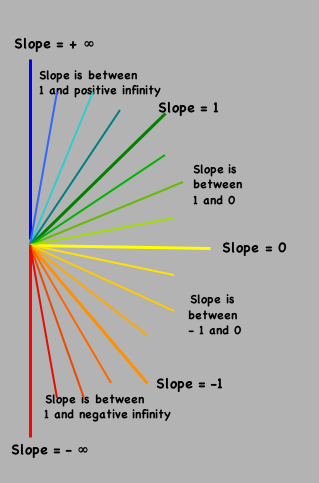
Review of Linear Slopes
The relationship between the price of
a good and the amount that a consumer is able and willing to buy
(i.e. the Demand Line) is a negative or inverse
relationship, which is represented by a line (or convex curve)
that is downward-sloping from upper left to lower right. It is a
negative (or inverse) relationship because one of the variables
is negative while the other is positive. They move in opposite
directions. If price rises (grows positively), the quantity
demanded by consumers falls (moves negatively).
In contrast, positive or direct
relationships are represented as upward sloped lines, from
bottom left to upper right. This is because both variables
increase together OR decrease together. They move in the same
direction. The Supply Line is the most common economic example
of a positively sloped line. When the price of a good rises in
the market producers are motivated to produce more of the good
in order to make more profit per unit sold. So, both price and
the amount produced (the quantity supplied) increase.
Alternatively, if the price of the good falls, producers will
cut production since they now make less profit per unit sold,
or may even lose money at a lower price. In this case both
price and the quantity produced fall or move in a negative
direction together.

Flat versus Steep Slopes
A negative-sloped Demand line that is
relatively flat indicates that consumers are very sensitive to
small changes in Price and respond with relatively large changes
in their purchasing behavior. Similarly, A postively sloped
Supply line that is relatively flat indicates that Producers are
very sensitive to small changes in Price because they respond
with a bigger change in production.
How do we know this?Because a relatively flat Demand line indicates that a small change in the vertical variable (Price) corresponds to a larger change in the horizontal variable (Quantity). This is particularly clear when you compare a "flattish" Demand line to a steep Demand line, which shows that a large change in the vertical variable is associated with a small change in the horizontal variable. Of course, the same comparison holds when you compare a flat Supply line with a steep Supply line.
For example, compare the difference in the vertical to horizontal relationships of a slightly negatively sloped line (say a light yellow one) to a very steep negatively-sloped line (say the red-orange line). Also compare the difference in the numerical value of the slope of flat Supply line (light green) to a steep Supply line (dark blue).
Being able to visually intepret both the mathematical concepts of graphs, as well as, the economic meaning of the graphs is a useful skill for introductory economics students.
Copyright 2003 - Philip R. Martinez and Lane Community College.
All Rights Reserved.